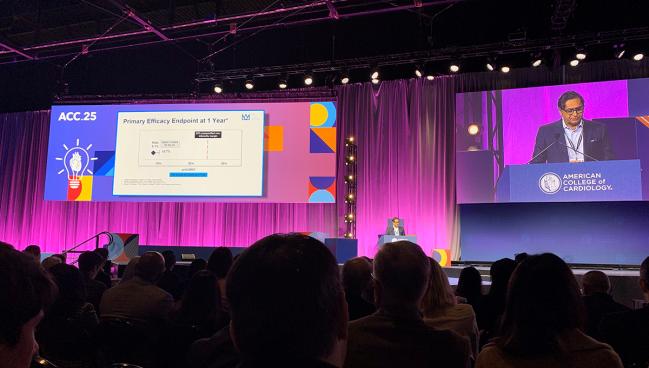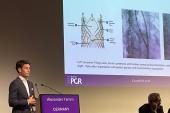More ALIGN-AR Data Bolster Potential for a Dedicated AR Device
Findings from the first 500 patients treated with the Trilogy system met noninferiority for both safety and efficacy.

CHICAGO, IL—TAVI using an investigational heart valve system (Trilogy; JenaValve) designed to treat aortic regurgitation (AR) is associated with lower-than-expected mortality and complication rates among patients at high risk for surgery, according to updated data from the ALIGN-AR trial.
Building off 2-year results from the first 180 patients presented last year at TCT 2024, the new findings are based on 500 patients and demonstrate an overall mortality rate of 8.1%, much lower than the 25% set as the noninferiority threshold for the primary efficacy endpoint (P < 0.001). Similarly, the trial met noninferiority for its primary safety endpoint and showed improvements in functional status and favorable LV remodeling.
“Not only do we actually provide evidence that this may be a valuable device in patients who are at high risk for surgery and were symptomatic, but also these data support starting a randomized clinical trial where this device is compared to surgery in lower-risk patients,” said Raj Makkar, MD (Cedars-Sinai Smidt Heart Institute, Los Angeles, CA), who presented the findings here today in a late breaking trials session at the American College of Cardiology 2025 Scientific Session.
Just such a trial, called ARTIST, has received funding and will begin enrolling 1,110 patients later this year then follow them for 10 years, he said.
Discussing the findings during the session, Roxana Mehran, MD (Icahn School of Medicine at Mount Sinai, New York, NY), called the device an “important breakthrough” for patients with AR—a population in need of treatment options.
Excellent Hemodynamics
The new analysis included 180 patients from the pivotal trial as well as 320 from the continued access population. Mean age was 76.6 years among those 500 individuals, and 46.2% were female. In total, 6-month follow-up was available in 426, 1-year in 389, and 2-year in 206. Mean STS score was 3.9, and 61.6% were classified as NYHA class III or IV at baseline. More than one-third had atrial fibrillation (AF), and 12.2% had right bundle branch block or bifascicular block.
Slightly over half of patients received large valves, and mean procedure time was 69 minutes. There were no reported intraprocedural deaths, annular ruptures, ventricular perforations, or coronary obstructions. Eight patients (1.6%) had valve embolizations, and three (0.6%) had aortic dissections. These complication rates were “much lower” than what has been seen with off-label use of TAVI devices to treat AR, Makkar reported.
The technique used in ALIGN-AR is “very practical,” he said, noting a 95.2% procedural success rate.
The rate of the primary safety endpoint—a composite of 30-day all-cause mortality, stroke, life-threatening/major bleeding, major vascular complication, acute kidney injury stage ≥ 2 or dialysis, valve intervention, new permanent pacemaker, and moderate or greater valvular regurgitation—was 26.2% and fell below the 40.5% prespecified noninferiority margin (P < 0.001).
While all-cause mortality did climb from 8.1% at 1 year to 15.5% by 2 years, Makkar said the difference was mostly due to noncardiac deaths.
The rates of disabling stroke were 3.1% and 3.6% at 1 and 2 years, respectively. These were “very reasonable considering the age of the patients” as well as the high rate of AF, he reported.
Hemodynamics were “excellent,” Makkar continued, with a mean effective orifice area (EOA) of 2.8 cm2 and mean gradient of 4.2 mm Hg. Rates of none/trace paravalvular regurgitation were 93.4% by 1 year and 95.7% at 2 years. Patients also reported favorable LV remodeling with significant reductions in LV volumes and mass. Quality of life improved as well, with only 8% and 10% of patients classified as NYHA class III or IV by 1 and 2 years, respectively. KCCQ overall summary scores improved significantly, too.
New pacemakers were needed in 23% and 24% of the pivotal trial and continued access populations, respectively. These rates are notably higher than the 10-11% seen with surgical treatment of AR, Makkar told TCTMD, and could be due to challenges with not having calcium to anchor the device in the annulus as happens with aortic stenosis as well as the presence of larger valves.
“It remains to be seen whether we can change our technique or whether the device will need to be somewhat modified,” he said.
Time to Test in Low-Risk Patients?
Cardiac surgeon S. Chris Malaisrie, MD (Northwestern University Feinberg School of Medicine, Chicago, IL), called on the researchers to carefully consider how patients will be treated in the control arm of future randomized studies, since surgeons currently treat AR by not only valve replacement but also repair.
“I think the design of the next trial is going be important, because you’re going to have to decide whether or not the control arm is going to include repair,” he said during a press conference. Also, he asked, is it appropriate to start investigating this technology in patients at low risk for surgery?
Mehran also questioned if it’s too soon to turn to the low-risk cohort, especially given that follow-up data is not yet available for all patients in the study. “I’m hoping you wait for the full mortality before you move to that direction,” she said.
“In the next 3 months, we’ll actually have full 1-year data in 500 patients and we’ll have 2-year data in almost 250 patients,” Makkar replied. “We feel that is enough. By the time the trial takes off, we’ll actually have this data and that should be enough.”
Speaking during the press briefing, Michael Reardon, MD (Houston Methodist DeBakey Heart & Vascular Center, TX), said, “One of the things that will be really interesting when we randomize against surgery is, unlike TAVR for a stenosis where we still have fairly small EOAs, the EOAs with these valves are getting really close to normal. And even if we compare it against aortic valve repair, it’s looking pretty good. It’s really amazing how well these valves do.”
AR patients are currently being treated with off-label TAVI devices with “quite high” complication rates, Makkar said.
“Once and if the device gets approved, I would hope that it would really open up a possibility for patients who are at high risk for surgery,” he told TCTMD. “And I would make the argument that unless there is a real reason, [it] should be the first choice [to use] a dedicated device rather than an off-label one.”
Yael L. Maxwell is Senior Medical Journalist for TCTMD and Section Editor of TCTMD's Fellows Forum. She served as the inaugural…
Read Full BioSources
Makkar RR. TAVR with JenaValve for symptomatic aortic regurgitation in high surgical risk patients outcomes in 500 patients from the ALIGN AR trial. Presented at: ACC 2025. Chicago, IL. March 30, 2025.
Disclosures
- Makkar reports receiving grant/research support from Edwards Lifesciences, Medtronic, Abbott, Boston Scientific, and JenaValve.





Comments